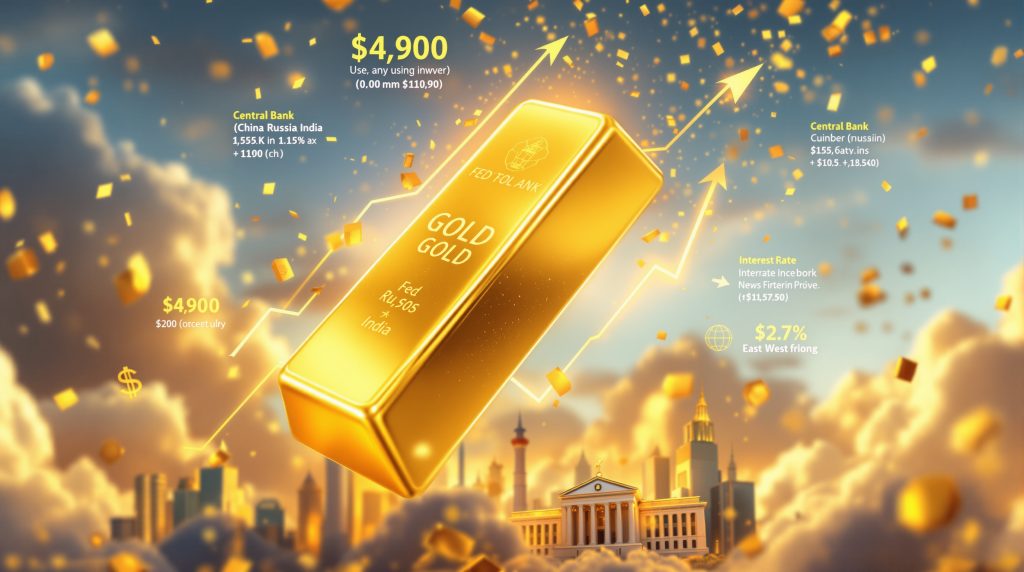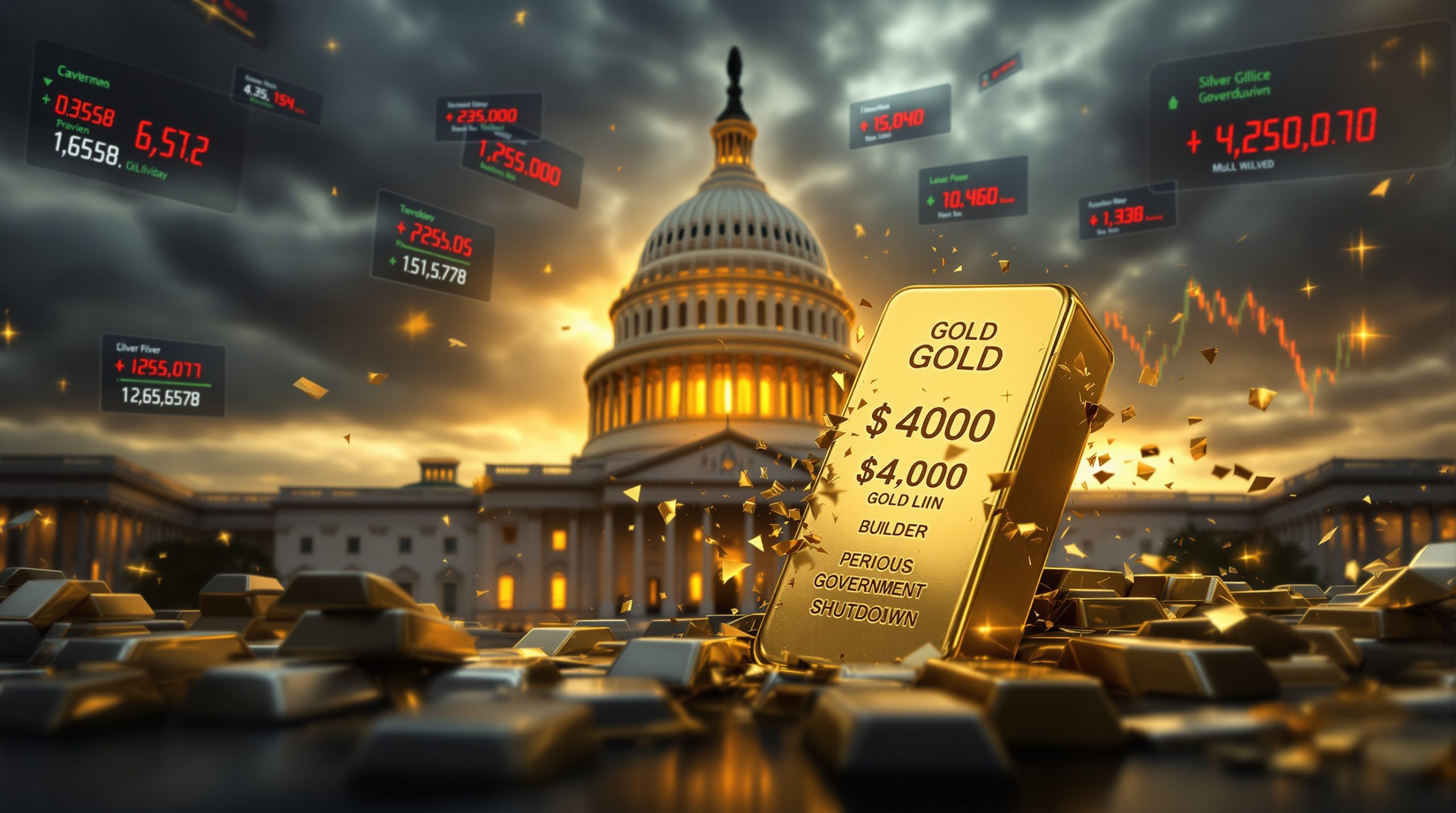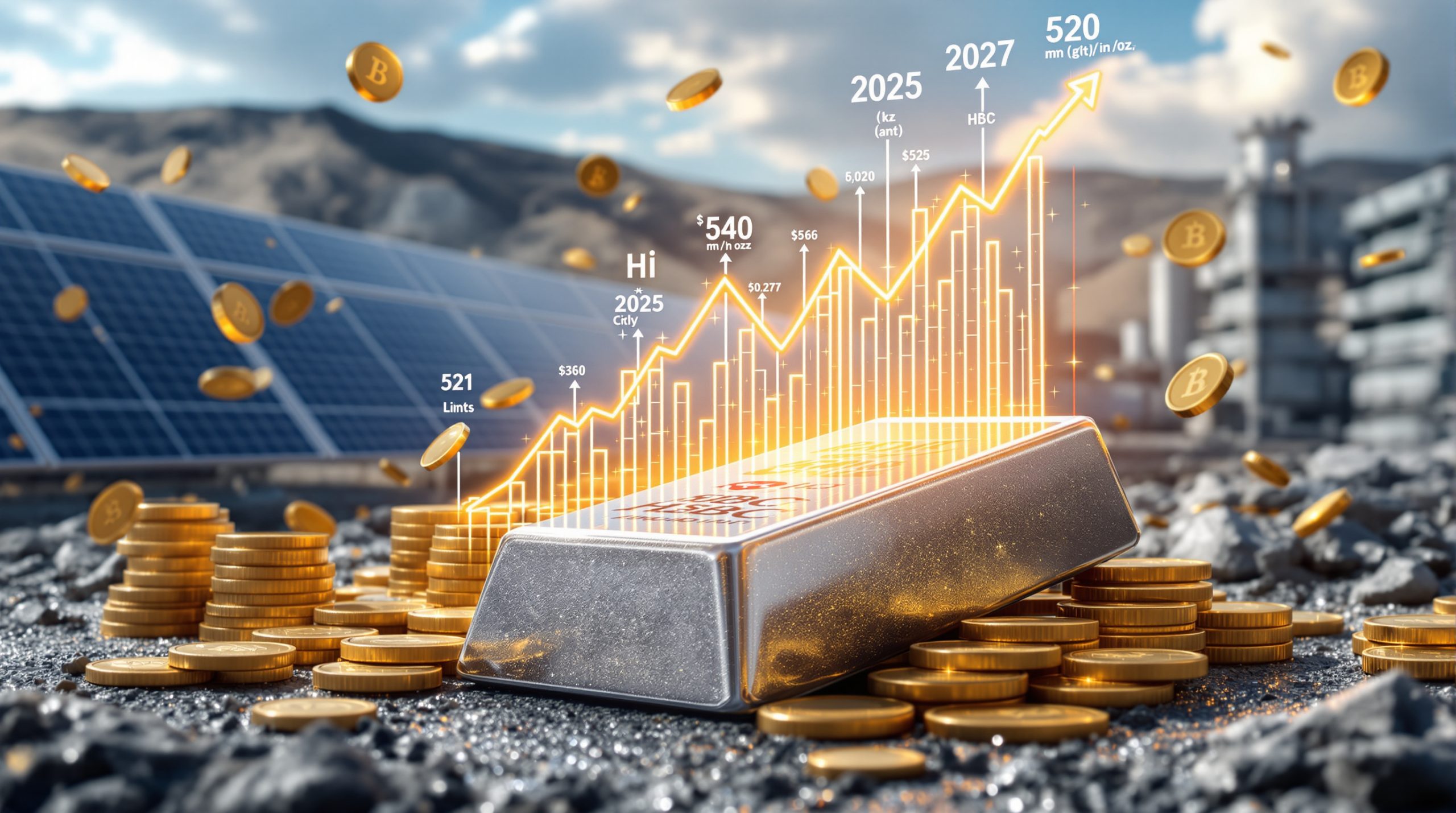What Factors Are Driving Gold's Price Trajectory Toward 2026?
Gold has captivated investors throughout history, but its current trajectory toward 2026 is being shaped by several powerful economic forces that warrant close examination. Understanding these drivers is crucial for investors considering investment strategies over the coming years.
Economic Policy Shifts
The Federal Reserve's anticipated rate-cutting cycle beginning in 2025 stands as perhaps the most significant catalyst for gold's potential upward movement. Historically, gold prices demonstrate inverse correlation with interest rates, as lower rates reduce the opportunity cost of holding non-yielding assets like precious metals.
Financial analysts project a gradual weakening of the US dollar through 2026, creating a favorable environment for dollar-denominated commodities. Currency depreciation typically enhances gold's appeal as a store of value, particularly when fiat currencies face pressures from expansionary monetary policies.
Global central banks are carefully navigating the path toward monetary policy normalization, with many expected to maintain accommodative stances through mid-decade. This cautious approach reflects persistent economic uncertainties and provides continued support for precious metals markets.
Inflation expectations play a critical role in gold pricing, with real interest rates (nominal rates minus inflation) serving as a key indicator for potential price movement. Even modest inflation combined with dovish monetary policy creates negative real rates—historically a powerful tailwind for gold appreciation.
Institutional Demand Dynamics
Central bank purchasing trends have emerged as a dominant force in gold markets, with acquisition rates reaching approximately twice historical averages. This structural shift represents a significant rebalancing of global monetary reserves and provides robust support for baseline pricing.
ETF inflows are anticipated to accelerate through 2025-2026 as institutional investors increase allocations to hard assets. These investment vehicles have democratized gold ownership and can amplify price movements when institutional sentiment aligns with bullish fundamentals.
A notable transformation is occurring in gold market influence, with Eastern central banks—particularly China—assuming greater dominance while Western institutions recalibrate their approaches to reserves management. This east-to-west power transition fundamentally alters traditional market dynamics.
Reserve diversification strategies among emerging market economies continue gaining momentum as these nations seek to reduce dependency on any single reserve currency. Gold's neutrality and absence of counterparty risk make it an attractive component in this strategic rebalancing.
Geopolitical Risk Assessment
Ongoing international conflicts have reinforced gold's traditional role as a safe-haven asset during periods of heightened uncertainty. The precious metal typically outperforms during geopolitical crises that threaten economic stability or raise questions about currency reliability.
Currency reserve rebalancing amid changing global power dynamics creates structural support for gold prices. As the international monetary system evolves toward multipolarity, gold benefits from its status as a neutral reserve asset not controlled by any single nation.
Trade tensions between major economies continue influencing commodity pricing and investment flows. Disruptions to global commerce often prompt investors to increase allocations to tangible assets with intrinsic value and limited supply.
Regional instability factors across multiple continents contribute to risk premiums in gold pricing. Political uncertainties in key mining regions can simultaneously impact both supply constraints and safe-haven demand—a powerful combination for price support.
How High Could Gold Prices Climb by 2026?
Forecasting precious metals prices requires analysis of multiple factors, from macroeconomic conditions to technical indicators. While predictions vary among financial institutions, there's remarkable consensus around significant upside potential through 2026.
Major Financial Institution Forecasts
TD Securities projects gold reaching $4,400 by the first half of 2026, representing substantial appreciation from current levels. This forecast stems from anticipated central bank demand, favorable monetary policy, and ongoing geopolitical uncertainties creating a supportive environment for precious metals.
Goldman Sachs has established a more bullish target of $4,900 by December 2026, positioning gold for potentially historic valuations. Their analysts cite structural supply constraints, institutional reallocation toward hard assets, and persistent currency debasement concerns as key drivers.
Deutsche Bank maintains a more conservative but still robust estimate of $4,000 throughout 2026. Their research emphasizes gold's traditional performance during periods of financial market volatility and its potential role as a portfolio stabilizer in late-cycle economic environments.
J.P. Morgan's prediction indicates gold reaching $4,000 by Q2 2026, aligning closely with industry consensus. Their analysis highlights central bank purchasing programs and anticipated shifts in real interest rate environments as primary catalysts.
InvestingHaven technical analysis suggests a ceiling projection of $4,200 in 2026, based on long-term chart patterns and historical resistance levels. Their methodology incorporates both fundamental drivers and technical price structures to establish projected ranges.
Price Milestone Timeline
The projected price journey toward 2026 can be broken down into key milestones that provide investors with a roadmap for potential entry and exit points:
| Period | Projected Price Range | Key Driving Factors |
|---|---|---|
| Q1 2026 | $3,800-$4,000 | Fed rate cut cycle, ETF inflows |
| Q2 2026 | $4,000-$4,200 | Seasonal demand patterns, central bank buying |
| H2 2026 | $4,200-$4,900 | Dollar weakness, investment positioning |
This timeline suggests an acceleration in the second half of 2026, potentially creating opportunities for strategic accumulation during earlier periods.
Technical Analysis Perspectives
Long-term resistance levels identified through multi-decade chart analysis suggest gold could encounter temporary obstacles near psychological price thresholds. However, once these resistance zones are cleared, technical analysts anticipate potential for rapid price discovery in previously uncharted territories.
Historical bull market comparison metrics indicate the current cycle demonstrates remarkable similarities to previous secular uptrends in gold, though with potentially greater magnitude due to unprecedented monetary expansion globally. Pattern recognition analysis suggests the 2020-2026 period may represent a super-cycle rather than a typical bull market.
Momentum indicators currently signal strong upside potential, with key metrics like relative strength and moving average convergence divergence supporting continued price surge performance. Technical analysts note that gold's price structure typically accelerates once long-term moving averages align in bullish formations.
Price channel projections through 2026 establish upper boundaries that correspond closely with institutional price targets. These technical frameworks provide context for potential volatility within the broader uptrend and help investors distinguish between short-term corrections and trend reversals.
Why Are Central Banks Accelerating Gold Purchases?
The dramatic increase in central bank gold acquisition represents one of the most significant structural shifts in precious metals markets. Understanding this phenomenon provides critical insight into long-term price support mechanisms.
Strategic Reserve Diversification
Central banks worldwide are executing a strategic shift away from dollar-denominated assets, reflecting concerns about concentration risk and seeking greater balance in reserve compositions. This diversification accelerated following geopolitical developments that highlighted potential vulnerabilities in traditional reserve systems.
Protection against currency devaluation risks has become a primary motivation for central bank gold acquisition. As monetary authorities navigate unprecedented expansion of global money supply, gold provides a hedge against potential purchasing power erosion of conventional reserve currencies.
Hedging against geopolitical uncertainties drives allocation decisions among monetary authorities seeking assets immune to sanctions or political leverage. Gold's borderless nature and universal recognition make it uniquely positioned for this strategic role in an increasingly fragmented international system.
Long-term wealth preservation strategies at the national level mirror individual investor motivations but at much larger scale. Central banks operate with multi-decade horizons that align with gold's historical performance as a store of value across centuries and monetary regimes.
Country-Specific Acquisition Trends
China's accelerated purchasing program, running at approximately twice its historical average, signals a fundamental reassessment of optimal reserve composition by one of the world's largest economies. This systematic accumulation occurs amid broader efforts to internationalize the yuan and reduce dollar dependency.
Russia's continued de-dollarization strategy has positioned gold as a cornerstone of its reserves restructuring. The systematic conversion of dollar holdings to gold reflects both economic calculations and strategic considerations in an evolving geopolitical landscape.
India's growing reserves amid economic expansion demonstrate the parallel tracks of modernization and traditional store-of-value principles. The world's second most populous nation maintains cultural affinity for gold while simultaneously developing sophisticated financial markets.
Emerging market central banks collectively account for a significant percentage of recent gold purchases, reflecting a consensus view on diversification benefits. These institutions often manage reserves in environments with greater currency volatility, enhancing gold's relative appeal.
Impact on Supply-Demand Balance
Central bank buying now represents approximately 25% of annual gold demand, creating a structural floor for prices during market corrections. This institutional absorption of physical metal occurs regardless of short-term price movements, providing stability to the overall market.
Reduction in available market supply for investment demand creates competitive dynamics between institutional and retail buyers. When both central banks and private investors increase allocations simultaneously, price discovery can accelerate rapidly due to gold's relatively inelastic supply.
Price support mechanisms during market corrections function more effectively when large buyers maintain consistent acquisition programs. The knowledge that significant institutional demand exists at lower price levels can discourage extreme selling pressure during temporary downturns.
Long-term structural shifts in ownership distribution are gradually transferring gold from Western financial institutions to Eastern central banks, fundamentally altering market dynamics. This geographic rebalancing creates more diverse demand patterns and potentially reduces historical price volatility.
What Supply-Side Factors Will Influence Gold Prices Through 2026?
While demand factors receive significant attention, supply constraints will likely play an equally important role in determining gold's price trajectory through 2026. The unique challenges facing gold production create conditions for potential supply limitations.
Mining Production Outlook
Global production plateau projections suggest limited growth potential in mining output through mid-decade. After years of aggressive cost-cutting following the 2011-2015 bear market, many producers prioritized balance sheet repair over exploration, creating a potential supply gap.
Major producer expansion plans and timelines indicate modest production increases insufficient to meet projected demand growth. Capital discipline among senior miners has constrained development budgets, with shareholders favoring dividends and share repurchases over aggressive expansion.
Grade decline issues at established operations present ongoing challenges for maintaining production levels. The natural depletion of higher-grade ore bodies forces miners to process larger volumes of lower-grade material to sustain output, increasing production costs and environmental footprints.
New project development schedules face extended timelines due to regulatory hurdles, environmental requirements, and community relations challenges. The period from discovery to production now averages 10-15 years for significant gold deposits, creating structural lags in supply response to higher prices.
Recycling Market Dynamics
Price sensitivity of recycling volumes demonstrates elastic response to gold price movements, with higher prices typically stimulating increased recycling activity. However, analysts note diminishing returns in recycling response as prices reach successive highs, suggesting potential supply limitations from this source.
Technology improvements in recovery processes continue enhancing recycling efficiency, though incremental gains face physical limitations. Advancements in urban mining and e-waste processing represent growing sources of recycled gold, particularly as electronics miniaturization increases gold content density in discarded devices.
Regional recycling capacity development shows uneven distribution globally, with significant processing concentration in specialized hubs. This geographic specialization creates potential bottlenecks during periods of price volatility when recycling volumes surge.
Contribution to overall supply balance from recycling typically ranges between 25-30% of annual supply but fluctuates with price movements and economic conditions. During economic hardship, recycling volumes increase as consumers monetize personal holdings, temporarily moderating price pressure.
Production Cost Inflation
Energy price impacts on mining operations significantly influence production costs, with fuel representing 15-20% of expenses at many operations. The industry's high energy intensity creates sensitivity to fossil fuel price volatility, prompting increased adoption of renewable energy solutions at mine sites.
Labor cost trends in major producing regions show upward pressure amid competition for skilled workers and inflationary wage environments. The specialized nature of mining expertise creates talent bottlenecks during expansion phases, potentially constraining production growth.
Equipment and consumables price trajectories demonstrate correlation with broader inflation measures and industrial commodity cycles. Mining operations require substantial ongoing capital investment in heavy machinery and processing equipment, creating exposure to manufacturing sector price dynamics.
Regulatory compliance cost increases reflect evolving environmental and social governance standards across the mining sector. These rising compliance requirements represent a structural shift in the industry's cost base rather than cyclical factors, establishing higher floor costs for future production.
How Does Gold's Performance Compare to Alternative Investments for 2026?
Strategic asset allocation requires comparative analysis across investment options. Gold's potential performance through 2026 must be evaluated against alternatives to determine optimal portfolio construction.
Comparative Asset Class Analysis
Gold versus equities in late-cycle economic environments typically shows divergent performance patterns. Historical data suggests gold often outperforms during periods of equity market stress, providing valuable diversification benefits when traditional investments face headwinds.
Precious metals versus fixed income during rate-cutting periods demonstrates important correlations worth examining. While both asset classes may benefit from falling interest rates, gold typically responds more dramatically to monetary easing, particularly when real yields turn negative.
Digital assets versus traditional safe havens represents a relatively new comparison dimension. While cryptocurrencies have attracted significant investment flows, their historical volatility and relatively short track record create different risk profiles compared to gold's millennia of monetary history.
Real estate correlation patterns during monetary easing cycles show complex relationships with precious metals performance. Both asset classes benefit from inflationary environments, though real estate carries greater sensitivity to credit conditions and demographic trends.
Portfolio Allocation Strategies
Optimal gold weightings for different risk profiles typically range from 5-15% for balanced portfolios, with higher allocations appropriate for investors seeking inflation protection or crisis hedging. This allocation range provides meaningful diversification benefits without overconcentration in a single asset class.
Tactical versus strategic holding approaches require different implementation methodologies. Long-term strategic allocations focus on gold's portfolio stabilization benefits across market cycles, while tactical positions may capitalize on specific macroeconomic catalysts with shorter timeframes.
Rebalancing considerations as prices appreciate become increasingly important during strong bull markets. Disciplined portfolio management may require trimming positions as gold reaches target allocations, though tax implications and transaction costs must be carefully evaluated.
Diversification benefits across market scenarios remain gold's most compelling portfolio attribute. The metal's historically low correlation with traditional financial assets creates unique portfolio efficiency improvements that can enhance risk-adjusted returns across varying economic conditions.
Risk-Adjusted Return Projections
Volatility expectations compared to other assets suggest gold may experience lower price variability than many alternative investments through 2026. The metal's established role in the global financial system and broad ownership base typically moderate extreme price movements relative to more speculative assets.
Sharpe ratio forecasts through 2026 indicate potentially attractive risk-adjusted returns for gold compared to traditional investments. These projections incorporate moderate price appreciation potential combined with gold's typically lower volatility compared to equity markets.
Drawdown protection characteristics historically demonstrate gold's resilience during severe market stress. While not immune to corrections, gold has typically experienced less severe peak-to-trough declines than equity indices during systemic crises.
Liquidity advantages during market stress periods represent one of gold's most valuable attributes. The metal's 24-hour global trading, narrow bid-ask spreads, and absence of counterparty risk allow investors to monetize holdings efficiently when other assets face liquidity constraints.
What Are the Key Investment Vehicles for Gold Exposure Through 2026?
Investors seeking gold exposure have numerous implementation options, each with distinct characteristics and trade-offs. Understanding these vehicles helps optimize execution based on individual objectives and constraints.
Physical Gold Ownership
Bullion bars and coins storage considerations include security, insurance, and verification requirements. Direct ownership provides maximum control but introduces logistical challenges requiring careful planning and potentially specialized storage solutions.
Premium trends for physical products fluctuate based on market conditions, with smaller units typically commanding higher percentage premiums over spot prices. Collector coins and limited mintages may attract additional premiums unrelated to their metal content, creating different investment dynamics.
Insurance and security cost factors represent ongoing expenses for physical gold holders. Professional storage solutions typically charge annual fees ranging from 0.5-1.5% of asset value, impacting long-term return calculations compared to paper gold alternatives.
Liquidity differences between product types create important distinctions for investors. Standard bullion products from recognized refiners maintain narrower bid-ask spreads than collectible or unusual items, providing more efficient entry and exit during normal market conditions.
Gold-Backed ETFs
Expense ratio comparisons between major funds show relatively minor differences, with annual costs typically ranging from 0.17-0.40%. These modest fees provide cost-effective exposure to gold price movements without physical storage requirements, though they introduce counterparty and custody considerations.
Tracking efficiency analysis demonstrates excellent correlation with spot gold prices among established ETFs. The largest funds maintain sufficient scale and operational expertise to minimize tracking error, allowing retail investors to closely mirror professional gold market performance.
Tax treatment differences by jurisdiction create important considerations for ETF investors. Various tax authorities classify gold ETFs differently, potentially affecting capital gains treatment, holding period requirements, and reporting obligations compared to direct ownership.
Trading volume and liquidity projections through 2026 suggest continued growth in ETF accessibility. Major gold ETFs consistently rank among the most actively traded securities globally, providing exceptional liquidity even during market stress periods.
Mining Equities Outlook
Producer versus explorer risk-reward profiles demonstrate important distinctions within the mining sector. Established producers offer operational cash flows and dividends while exploration companies provide leverage to discovery potential but with substantially higher failure risks.
Margin expansion potential at higher gold prices creates operating leverage that historically amplifies mining equity returns during bull markets. A producer with $1,200/oz production costs experiences dramatically different profit margins at $2,000/oz versus $4,000/oz gold prices.
Dividend yield expectations through 2026 suggest continued emphasis on shareholder returns among major producers. The sector has emphasized capital discipline following previous boom-bust cycles, with many companies establishing dividend policies linked to free cash flow generation.
Valuation metrics compared to historical averages provide context for current mining equity prices. Price-to-NAV, EV/EBITDA, and free cash flow yield metrics help investors assess relative value within the sector and compared to broader equity markets.
How Might Economic Scenarios Impact Gold's 2026 Price Trajectory?
Gold's performance through 2026 will be significantly influenced by broader economic developments. Examining potential scenarios helps investors anticipate price responses across various macroeconomic environments.
Recession Protection Scenario
Economic contraction response patterns historically demonstrate gold's resilience during recessionary periods. While not immune to initial liquidity-driven selling pressure, gold typically recovers more rapidly than risk assets when economic conditions deteriorate.
Historical performance during downturns shows varying gold price behavior based on recession severity and monetary policy response. The most favorable environments for gold typically combine economic stress with aggressive central bank intervention, creating both safe-haven demand and currency debasement concerns.
Flight-to-safety capital flows during market stress periods often benefit gold alongside traditional safe havens like Treasury bonds. These correlated movements can temporarily disrupt gold's portfolio diversification benefits but typically normalize as market conditions stabilize.
Monetary policy reaction functions during economic contractions almost universally favor accommodative stances, creating supportive environments for non-yielding assets like gold. The speed and magnitude of central bank response significantly influence gold's relative performance during these periods.
Inflation Resurgence Case
Real interest rate implications of higher inflation create potentially ideal conditions for gold appreciation. When inflation outpaces nominal interest rates, the resulting negative real yields reduce opportunity costs for holding precious metals while simultaneously eroding cash purchasing power.
Purchasing power preservation metrics demonstrate gold's historical effectiveness during inflationary regimes. While short-term correlations with inflation can be inconsistent, longer measurement periods consistently show gold maintaining relative value during currency debasement.
Commodity correlation patterns during inflationary periods typically show broad-based price increases across the resource spectrum. Gold often leads these moves due to its monetary characteristics, though it generally experiences less extreme price volatility than industrial or agricultural commodities.
Stagflation protection characteristics historically favor gold over most conventional financial assets. The combination of economic stagnation and persistent inflation creates particularly challenging environments for both equities and bonds while enhancing gold's relative appeal.
Soft Landing Possibility
Moderate growth impact assessment suggests gold could still perform reasonably well even in benign economic scenarios. Continued central bank purchases, structural supply constraints, and modest portfolio allocations provide support even without crisis catalysts.
Balanced portfolio positioning in stable growth environments typically maintains precious metals exposure for diversification benefits. Even during favorable economic conditions, gold's low correlation with traditional assets enhances portfolio efficiency metrics.
Opportunity cost considerations become more relevant during robust growth periods with rising real yields. Strong economic performance without inflation pressure typically creates the most challenging environment for gold due to competition from yield-bearing alternatives.
Sentiment-driven price movements may create greater volatility during economic transitions as investors recalibrate risk assessments. These sentiment shifts can create both challenges and opportunities for strategic gold accumulation depending on market timing.
What Technical Indicators Support Higher Gold Prices by 2026?
Technical analysis provides important perspectives on gold's price structure and momentum characteristics. These indicators complement fundamental analysis and help establish potential price targets and trajectory.
Long-Term Chart Patterns
Multi-year cup and handle formation completion signals potential for sustained upward movement. This classical pattern typically indicates consolidation followed by continuation, with the measured move suggesting significant upside potential from the breakout point.
Decade-long resistance breakout implications become increasingly relevant as gold establishes new price territories. The psychological and technical significance of these breakouts often attracts momentum-driven capital and validates fundamental bullish narratives.
Moving average alignment supporting uptrend shows important convergence of short, intermediate, and long-term price momentum. This technical structure typically precedes periods of accelerated price discovery when fundamental catalysts align with positive technical setups.
Volume profile supporting higher price levels indicates institutional participation rather than speculative excess. Healthy bull markets demonstrate rising volume during price advances and lower volume during consolidations, suggesting sustainable buying interest.
Momentum Analysis
Relative strength indicator projections suggest potential for continued upward momentum through key resistance levels. These mathematical measurements of price velocity help identify potential acceleration phases within longer-term trends.
MACD signal confirmation patterns provide insights into momentum sustainability and potential reversal points. The relationship between these moving averages helps technical analysts distinguish between temporary corrections and trend changes.
Rate of change acceleration metrics indicate increasing momentum typically precedes major price advances. These measurements help quantify not just price direction but the velocity and acceleration characteristics that often accompany major market moves.
Bullish divergence identification between price and momentum indicators can signal potential trend reversals or continuation after corrections. These technical relationships often provide early warning of changing market dynamics before price confirmation occurs.
Market Sentiment Measurements
Institutional positioning analysis through commitment of traders reports provides insights into professional market sentiment. The relative positioning of commercial hedgers versus speculative traders offers valuable context for price movements and potential turning points.
Retail investor participation metrics help identify market cycle positioning through various sentiment surveys and fund flow data. Extreme readings in either direction often coincide with important market turning points worth monitoring.
Options market sentiment indicators reveal positioning expectations through put-call ratios and volatility skew measurements. These derivatives market signals provide insights into market participant positioning and hedging activities.
Futures market commitment of traders patterns demonstrate evolving institutional perspectives on price trajectory. The relative positioning of commercial versus non-commercial traders helps identify potential supply/demand imbalances in derivatives markets that influence spot pricing.
FAQ: Gold Price Forecast 2026
What is the highest gold price projection for 2026?
Goldman Sachs provides the most bullish forecast among major financial institutions, projecting gold to reach $4,900 per ounce by December 2026. This target represents substantial appreciation from current levels and would establish new all-time high analysis in both nominal and inflation-adjusted terms. The projection incorporates continued central bank purchases, ETF investment flows, and an anticipated weakening dollar environment through mid-decade.
How will interest rate changes affect gold prices through 2026?
The Federal Reserve's expected rate-cutting cycle beginning in 2025 creates a favorable backdrop for gold appreciation. Historically, gold demonstrates strongest performance when real interest rates (nominal rates minus inflation) turn negative or decline significantly. Lower interest rates reduce the opportunity cost of holding non-yielding assets like gold while simultaneously raising concerns about currency debasement that enhance gold's appeal as a monetary alternative.
Will gold mining stocks outperform physical gold by 2026?
Mining equities typically provide operational leverage to gold prices, potentially outperforming the metal during sustained bull markets. With production costs relatively stable, profit margins could expand dramatically if gold reaches $4,000+ per ounce, driving superior returns for quality producers. However, this outperformance comes with increased volatility and company-specific risks that don't affect physical gold. Investors should carefully evaluate management quality, production profiles, and balance sheet strength when selecting mining investments.
How might geopolitical developments impact the 2026 gold forecast?
Escalating international tensions, trade disputes, and regional conflicts would likely accelerate gold's upward momentum forecast. The metal traditionally serves as a geopolitical hedge, attracting capital during periods of heightened uncertainty or instability. Conversely, meaningful diplomatic breakthroughs could moderate safe-haven demand, though structural factors supporting higher prices would remain intact. The geographic rebalancing of gold ownership toward Eastern nations also represents a long-term geopolitical shift influencing market dynamics.
What factors could cause gold prices to underperform these forecasts?
Potential headwinds include faster-than-expected economic growth reducing safe-haven demand, central banks slowing their purchasing pace, technological disruption in mining increasing supply, or a significant strengthening of the US dollar contrary to current expectations. Additionally, substantial increases in real interest rates would raise the opportunity cost of holding gold, potentially dampening investment demand. Unexpected policy shifts toward aggressive monetary tightening would represent the most significant risk to bullish gold forecasts.
How does gold's projected performance compare to digital assets through 2026?
Gold and digital assets like cryptocurrencies potentially serve complementary rather than competitive roles in investment portfolios. While both may benefit from currency debasement concerns, they demonstrate significantly different volatility profiles and adoption characteristics. Gold's millennia-long monetary history and broad institutional acceptance contrast with digital assets' technological innovation and potential disruption. Investors increasingly view these asset classes as addressing different portfolio needs rather than direct substitutes for one another.
What allocation to gold is recommended for balanced portfolios through 2026?
Financial advisors typically recommend gold allocations between 5-15% for balanced portfolios seeking diversification benefits. The specific percentage depends on individual risk tolerance, investment objectives, and correlation benefits within the broader portfolio context. Higher allocations may be appropriate for investors particularly concerned about inflation protection or seeking crisis hedging. Regular rebalancing becomes increasingly important as gold prices appreciate to maintain target allocations and risk parameters.
How might central bank digital currencies affect gold demand through 2026?
The accelerating development of central bank digital currencies (CBDCs) creates both challenges and opportunities for gold. While CBDCs may enhance monetary authorities' policy implementation capabilities, they simultaneously raise questions about financial privacy and potential capital controls that could increase demand for non-sovereign alternatives like gold. The transition toward digital currency systems may paradoxically strengthen rather than diminish gold's appeal as a counterbalance to expanding government monetary influence.
Ready to Spot the Next Major Mineral Discovery?
Unlock your market-leading edge with Discovery Alert's proprietary Discovery IQ model, which instantly notifies investors of significant ASX mineral discoveries and turns complex data into actionable insights. Explore our dedicated discoveries page to understand why major mineral discoveries can lead to extraordinary market returns, and begin your 30-day free trial today.




